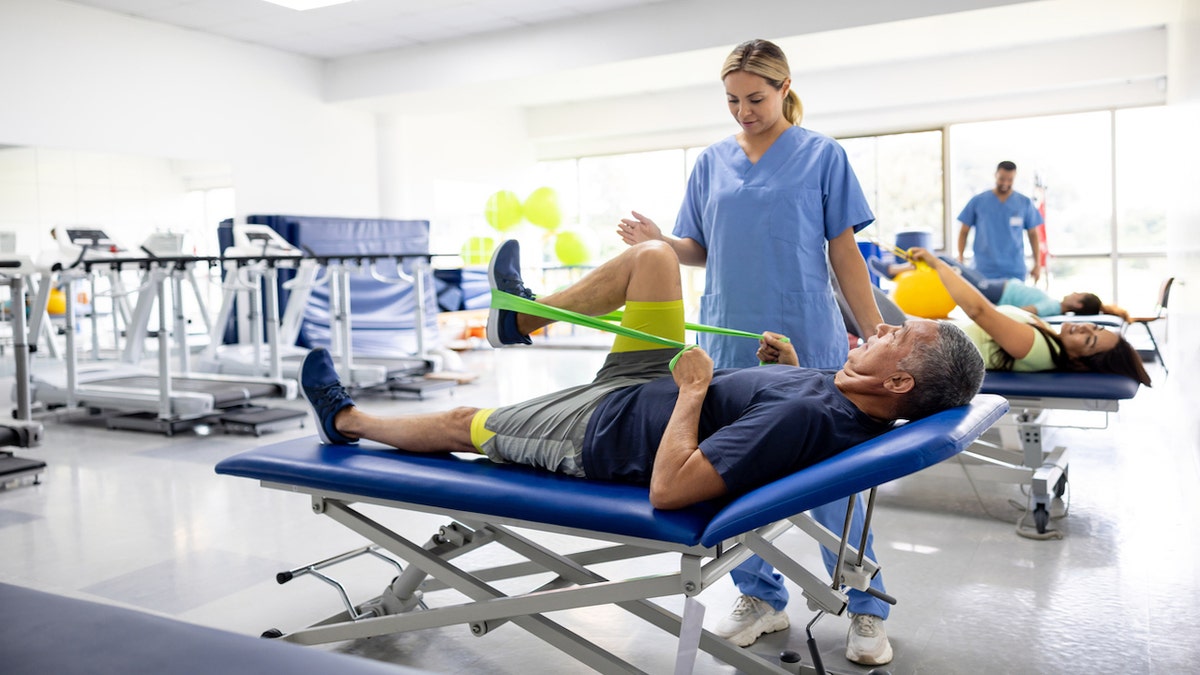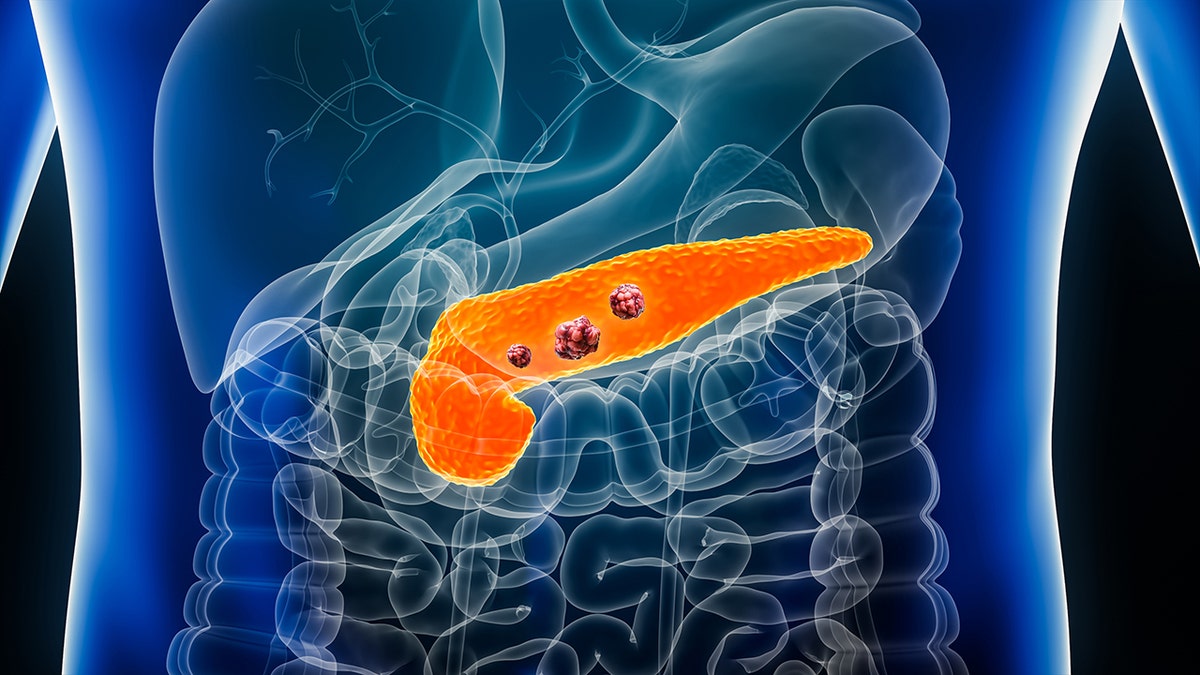Health
As physical therapist practices in America face staffing shortages, kids are ‘suffering,’ say experts

The physical therapist will not see you now.
Outpatient physical therapist (PT) practices are experiencing severe staff shortages, with the highest vacancy rates at 17%, according to a recent report by the American Physical Therapy Association (APTA), a nonprofit group based in Virginia.
The report is based on survey responses from 133 outpatient physical therapy practices across the U.S., which include 2,615 clinics and some 11,000 full-time employees, ranging from support staff to PTs. The survey was conducted between May 25 and June 16.
LESS THAN HALF OF NURSES ARE ‘FULLY ENGAGED’ AT WORK, WHILE MANY ARE ‘UNENGAGED,’ NEW REPORT REVEALS
The pandemic may have accelerated the staffing shortage, but only 1.7% of owners of physical therapy practices cited COVID-19 as the primary reason for leaving, per the press release.
Here is more detail about the survey results — and what they mean.
Outpatient physical therapist practices are experiencing severe staff shortages, per a recent report by the American Physical Therapy Association. (iStock)
Factors driving PTs to leave
Most survey respondents said the big drivers of employee loss were salary, relocation and work-life balance issues.
Among the business owners, 37.3% cited relocation, 25.4% blamed salary and 22.9% said issues with work-life balance were the reason that employees left practices.
SPENDING THE NIGHT IN AN EMERGENCY ROOM PUTS OLDER ADULTS AT HIGHER RISK OF DYING IN THE HOSPITAL: STUDY
“There is certainly a shortage of physical therapists, especially here in New York, and the pediatric population is suffering,” Dr. Susan Taddonio, assistant professor at Long Island University and a practicing pediatric physical therapist based in New York, told Fox News Digital.
Physical therapists are also retiring, changing careers or selling their practices to corporate entities, added Taddonio, who was not involved in the survey.

Most survey respondents said the big drivers of the loss of physical therapists were salary, relocation and work-life balance issues. (iStock)
“The sad fact is that we go into physical therapy with a major desire to improve the lives of the people we serve … and the rewards at the end make meeting the costs of living and paying off student debt difficult at best,” Dr. Marilyn Moffat, professor of physical therapy at New York University in New York, New York, told Fox News Digital.
Sizable student debts
It’s tough for many potential students to rationalize investing in a physical therapy education that may not yield a return on their investment, added Moffat, who was not part of the survey.
Students typically spend four years earning a bachelor’s degree before embarking on a three-year program to graduate as a doctor of physical therapy.
“To become a licensed PT, you need to earn a doctorate degree,” Taddonio emphasized.
“We go into physical therapy with a major desire to improve the lives of the people we serve … and the rewards at the end make meeting the costs of living and paying off student debt difficult at best.”
“This can lead to a large amount of student debt, and when compared to other fields, the earning potential is not as great — especially with [high] burnout rates and the burden the job places on one’s body.”
Meanwhile, she noted, nurses and physician assistants can graduate sooner with less debt and earn more pay.

“There is a shortage of physical therapists, especially here in New York, and the pediatric population is suffering,” said a physical therapist. (iStock)
The median annual wage of physical therapists ranges from $88,000 to $101,500, but this income only met or fell behind the inflation rate in most areas of the country between 2016 and 2021, according to the APTA’s most recent published data.
At least 80% of recent physical therapy graduates have an average debt of $142,000, per a 2020 report.
Lower Medicare reimbursements
The Centers for Medicare & Medicaid Services (CMS) is planning an additional reduction in reimbursement that will affect physical therapists in 2024, which would bring the cuts to a total of 9% over four years, according to APTA.
(Medicare reimbursements are payments that Medicare sends to hospitals and physicians for medical services they provide.)
BURNT OUT AND GETTING OUT: AMERICAN HOSPITALS STRUGGLE WITH INCREASING SHORTAGE OF NURSES
“On Nov. 2, 2023, CMS issued a final rule that finalized policy changes for Medicare payments under the Physician Fee Schedule (PFS) and other Medicare Part B issues, effective on or after Jan. 1, 2024,” a CMS spokesperson told Fox News Digital.
The policy changes “reflect a broader Biden-Harris administration-wide strategy to create a more equitable health care system that results in better access to care, quality, affordability and innovation,” according to the CMS.

Medicare patients make up a large percentage of the people that physical therapists treat, which means new graduates are finding it increasingly challenging to establish small private practices that will be sustainable. (iStock)
Although finalized payment amounts under the PFS will be reduced by 1.25% overall next year compared to the 2023 calendar year, CMS is finalizing increases in payments for many services, such as primary care visits and longitudinal care visits.
“Overall, the finalized [calendar year] 2024 PFS conversion factor is $32.74, a decrease of $1.15, or 3.4%, from [calendar year] 2023,” the CMS spokesperson said.
NATIONAL NURSING SHORTAGE HITTING RURAL AMERICA HARDEST
Medicare patients make up a large percentage of the people that physical therapists treat, which means new graduates are finding it increasingly challenging to establish small private practices that will be sustainable.
“In the past, we could … actually establish a nice private practice and even have that grow into several practices,” Moffat said.
“However, because the publicly held and private equity-backed major firms have and continue to buy up small practices where the bottom line is the major consideration, it is now extremely difficult — if not impossible — to think about being entrepreneurial and starting that small practice.”
Regulatory changes for remote services
Several recent regulatory changes should give physical therapists and occupational therapists more flexibility in providing services to patients, the CMS spokesperson told Fox News Digital.

Several recent regulatory changes should give physical therapists and occupational therapists more flexibility in providing services to patients. (iStock)
Since 2005, CMS has required physical therapists in private practices to provide direct supervision of their therapy assistants.
“CMS is finalizing a regulatory change to allow for general supervision of therapy assistants by PTPPs (physical therapists in private practice) and OTPPs (occupational therapists in private practice) for remote therapeutic monitoring (RTM) services,” the CMS spokesperson said.
“Practically, this means that physical therapists and occupational therapists will not need to be physically present to supervise RTM services.”
Long wait times for children
A particular population of patients is adversely affected by the shortage of physical therapists, Taddonio noted.
“We have seen children in the early intervention system waiting months to get a therapist,” she said.
CLICK HERE TO SIGN UP FOR OUR HEALTH NEWSLETTER
Early intervention services help address the developmental needs of eligible infants and toddlers with disabilities up to 3 years old and their families, Taddonio said.
They are authorized by Part C of the Individuals with Disabilities Education Act (IDEA).

“We have seen children in the early intervention system waiting months to get a therapist,” a PT said. (iStock)
“The data from early intervention reported a 33% drop [in] children being identified and serviced each year since COVID in 2019,” said Taddonio.
She has not seen pay increases for the preschool population in years — a trend she attributes largely to budget and Medicaid cuts.
“In the past 30 years that I’ve been practicing, early intervention has made two reductions in the pay rate,” the physical therapist said.
Fox News Digital reached out to the American Physical Therapy Association for additional comment.
For more Health articles, visit www.foxnews.com/health.

Health
Mom’s Gripes About Sister-in-Law Put Daughter in a Bind

My mother is hypercritical of my brother’s wife, to the point that she blames my sister-in-law for my brother’s “failings” (not getting a better job, not taking better care of his health, etc.). It has gotten worse now that there are grandchildren. My mother constantly criticizes how my sister-in-law is raising the kids, who are lovely and adore their grandparents.
Although my mother will occasionally raise criticisms with my sister-in-law and brother, I am mostly her audience.
I have a great relationship with my sister-in-law, and when my mother goes off on one of her rants, I defend her. I tell my mother how lucky she is to have such wonderful grandchildren, and point out that my brother is an adult who makes his own decisions. This just leads to an argument between my mother and me.
When I finally told my mother how much it hurts me to hear her say these things about my sister-in-law, she said that she needed to air her frustrations with someone. I want to be there for my mother, but I don’t like being put in this position. How do I navigate this?
From the Therapist: The short answer to your question is that you can navigate this by no longer engaging in these conversations. But I imagine you already know this. What you might be less aware of is that you aren’t being “put in this position” of supportive daughter, protective sister-in-law and unwilling confidante. You’ve chosen it, and it’s worth examining why you’ve signed up for a job you don’t want — and what makes it hard to resign.
Usually when we find ourselves repeatedly engaging in uncomfortable family patterns, it’s because they echo familiar roles from our childhood. It sounds as if you’re struggling with enmeshment, a relationship pattern in which boundaries between family members become blurred or are nonexistent.
Think of enmeshment as being like two trees that have grown so close together that their branches have become intertwined. While this might look like closeness, it actually prevents either tree from growing in a healthy way. In your case, your mother’s emotions and grievances have become so entangled with your own emotional life that it’s hard to distinguish where her feelings end and yours begin.
You mention wanting to “be there” for your mom even though these conversations hurt you. Many adult children who struggle to say no to their parents grew up serving as their parents’ emotional support system, or absorbing their parents’ feelings, even at the expense of their own. When you told your mother how much her venting hurt you, she responded not by acknowledging your feelings, but by asserting her need to “air her frustrations.” Her response reveals something important: She sees you as a vessel for her emotional overflow rather than as someone with valid feelings of your own. And yet, despite your hurt, you’re still more concerned about her feelings than yours.
You’re asking how to navigate this situation, but I think the deeper question is: How can you begin to value your own emotional needs?
You can start by reframing what it means to make a reasonable request, which is essentially what setting a boundary is. A boundary isn’t about pushing someone away. Instead, it’s about making a bid for connection. It’s saying: “I want to feel good being close to you, but when you do X, it makes me want to avoid you. Help me come closer.”
Establishing a boundary consists of three steps:
-
State the issue and the desire to come closer (what will make this possible): “Mom, I love you and want to support you, but these conversations about my sister-in-law put me in an impossible position and make me want to avoid talking with you, which I know isn’t what either of us wants. I’m happy to talk about other things together, but in order to keep our relationship strong, I need this topic to be off limits.”
-
Set the boundary (what you will do): “If you’re struggling with their choices, I’m happy to support you in finding a therapist who can help you work through these feelings. But if you bring up these frustrations with me, I’m going to end the conversation and we can talk another time about other things.”
-
Hold the boundary (do what you say): A boundary isn’t about what the other person will or won’t do. A boundary is a contract with yourself. If you say you’ll end the conversation when your mom brings up your sister-in-law, you need to hold that boundary every single time. If you end the conversation only 90 percent of the time, then why would the other person honor your request when 10 percent of the time, you can’t honor it yourself? Honoring your request might sound like: “Mom, I’m going to end the conversation now because I’m not comfortable talking about my sister-in-law. I love you, and we’ll talk later.”
If you start to feel guilty, remember that just because someone sends you guilt doesn’t mean you have to accept delivery. Remind yourself that when you become your mother’s outlet for criticism of your sister-in-law, you’re participating in a cycle that strains loyalties and causes you personal distress. And keep in mind that being a good daughter means setting boundaries that encourage our parents to grow, rather than enabling patterns that harm our family relationships.
Want to Ask the Therapist? If you have a question, email askthetherapist@nytimes.com. By submitting a query, you agree to our reader submission terms. This column is not a substitute for professional medical advice.
Health
Cancer death rates decline yet new diagnoses spike for some groups, says report

Alcohol linked to 7 types of cancer
Dr. Nicole Saphier joins ‘America’s Newsroom’ to discuss the surgeon general pushing for cancer warning labels on alcohol and the CDC warning of norovirus cases surging in parts of the U.S.
A major annual cancer report has revealed a mix of good news and points of concern.
Cancer diagnoses are expected to exceed two million in 2025, with approximately 618,120 deaths predicted, according to the American Cancer Society’s annual cancer trends report, which was published today in CA: A Cancer Journal for Clinicians.
ACS researchers compiled data from central cancer registries and from the National Center for Health Statistics.
ALCOHOL LINKED TO CANCER RISK IN US SURGEON GENERAL’S NEW ADVISORY
While mortality rates have declined, certain groups are seeing a spike in diagnoses, the report noted.
Cancer diagnoses are expected to exceed two million in 2025, with approximately 618,120 deaths predicted. (iStock)
“Continued reductions in cancer mortality because of drops in smoking, better treatment and earlier detection is certainly great news,” said lead author Rebecca Siegel, senior scientific director of surveillance research at the ACS in Georgia, in a press release.
“However, this progress is tempered by rising incidences in young and middle-aged women, who are often the family caregivers, and a shifting cancer burden from men to women, harkening back to the early 1900s, when cancer was more common in women.”
Overall decline in death rates
Cancer death rates dropped 34% between 1991 and 2022, according to the ACS report.
That equates to approximately 4.5 million deaths avoided due to early detection, reductions in smoking, and improvements in treatment, the report stated.
Cancer death rates dropped 34% between 1991 and 2022.
Several factors likely contributed to this decline, noted John D. Carpten, Ph.D., chief scientific officer at City of Hope, a national cancer research and treatment organization in California.
“I think a big one is smoking cessation and the battle against lung cancer, which has always been the most common form of cancer and is tied to tobacco use,” Carpten told Fox News Digital in an on-camera interview.

“Screening programs are a critical component of early detection, and expanding access to these services will save countless lives.” (iStock)
“But without a doubt, I think new and better methods for early detection, and screening for colorectal cancer and other forms of the disease, have also allowed us to see a decrease.”
Lifestyle improvements have also helped to decrease mortality, he said, along with the development of new and better therapies for cancer.
LIVER CANCER PATIENT GIVEN 6 MONTHS TO LIVE LOSES 76 POUNDS EATING SPECIFIC FOODS
Despite overall declines in mortality, the report revealed that death rates are rising for cancers of the oral cavity, pancreas, uterine corpus and liver (for females).
Some common cancers have also seen an increase in diagnoses, including breast (female), prostate, pancreatic, uterine corpus, melanoma (female), liver (female) and oral cancers associated with the human papillomavirus, the report stated.
Increased diagnoses among certain groups
Diagnoses for many cancer types are increasing among certain groups.
Cancer rates for women 50 to 64 years of age have surpassed those for men, the report revealed. For women under 50, rates are 82% higher than males in that age group.

The report revealed that diagnoses of colorectal cancer in men and women under 65 and cervical cancer in women between 30 and 44 years of age has increased. (iStock)
As far as what is influencing the “disconcerting trend” in women’s cancers, Carpten said it is likely “highly nuanced” and will require additional research.
“The decrease in fertility and increases in obesity that we’ve seen are risk factors for breast cancer, especially in postmenopausal middle-aged women,” he said.
“But there could be other modifiable risk factors at play, like alcohol and physical activity.”
Cancer rates for women 50 to 64 years of age have surpassed those for men.
Another trend in the increase in early cancers is occurring in individuals under the age of 50, Carpten noted.
In particular, the report revealed that diagnoses of colorectal cancer in men and women under 65 and cervical cancer in women between 30 and 44 years of age has increased.

Some common cancers have also seen an increase in diagnoses, including breast (female), prostate, pancreatic, uterine corpus, melanoma (female), liver (female) and oral cancers associated with the human papillomavirus. (iStock)
The report also discusses inequities in cancer rates among certain ethnic groups, with Native American and Black people experiencing higher diagnoses of some cancer types.
“Progress against cancer continues to be hampered by striking, wide static disparities for many racial and ethnic groups,” said senior author Dr. Ahmedin Jemal, senior vice president of surveillance and health equity science at the ACS, in the release.
AI DETECTS OVARIAN CANCER BETTER THAN HUMAN EXPERTS IN NEW STUDY
The report shows mixed trends for children, with diagnoses declining in recent years for patients 14 years of age and younger, but rising for adolescents between 15 and 19.
“Mortality rates have dropped by 70% in children and by 63% in adolescents since 1970, largely because of improved treatment for leukemia,” the ACS stated in the release.
Pancreatic cancer a growing concern
The ACS report also warns about “lagging progress” against pancreatic cancer, the third-leading cause of cancer death in the U.S.

The ACS report also warns about “lagging progress” against pancreatic cancer, the third-leading cause of cancer death in the U.S. (iStock)
Rates of diagnoses and deaths from the disease type are on the rise.
“Pancreatic is an incredibly deadly form of cancer,” Carpten said.
One of the main issues with pancreatic cancer, he said, is that it sometimes can grow in an individual for up to 10 years before it’s detected.
“If we can identify those cancers when they’re at at a curable stage, we can improve outcomes.”
One of the best opportunities for beating pancreatic cancer is early detection, Carpten said.
“By the time those cancers have advanced, they’ve spread to the liver or other organs, and they’re almost impossible to cure at that stage,” he said.
“If we can identify those cancers when they’re at a curable stage, we can improve outcomes.”
‘It takes a village’
Making progress in fighting cancer “takes a village,” Carpten told Fox News Digital.
“It will require partnerships between the community, the health care system, cancer researchers, government, industry — we all have to work together if we want to continue to see a decrease and an ultimate increase in cures,” he said.

“We all have to work together if we want to continue to see a decrease and an ultimate increase in cures,” a cancer researcher said. (iStock)
Dr. Wayne A. I. Frederick, interim chief executive officer of the American Cancer Society and the American Cancer Society Cancer Action Network (ACS CAN), stated that the report highlights the need to “increase investment in both cancer treatment and care, including equitable screening programs.”
CLICK HERE TO SIGN UP FOR OUR HEALTH NEWSLETTER
“Screening programs are a critical component of early detection, and expanding access to these services will save countless lives,” he said in the release.
For more Health articles, visit www.foxnews.com/health
“We also must address these shifts in cancer incidence, mainly among women. A concerted effort between health care providers, policymakers and communities needs to be prioritized to assess where and why mortality rates are rising.”
Fox News Digital reached out to the ACS for further comment.
Health
FDA Moves Forward With Last-Minute Push to Cut Nicotine Levels in Cigarettes

The Biden administration unveiled a proposal on Wednesday to cut the level of nicotine in cigarettes, a last-minute push on a plan that could meaningfully cut cancer rates nationwide and extend the lives of millions of cigarette smokers.
If finalized, the proposal would require cigarette makers to significantly reduce the levels of nicotine in their products in an effort to make smoking less addictive and less satisfying. Research has suggested that the move would result in fewer people taking up the habit and would help the nation’s roughly 30 million smokers quit or switch to less harmful alternatives like e-cigarettes.
The policy is a centerpiece of antismoking initiatives by Dr. Robert Califf, commissioner of the Food and Drug Administration, who has recounted treating cardiology patients ravaged by smoking during his medical career.
“It’s the biggest thing I’ve ever seen in terms of societal benefit, cost saving and lives saved, and strokes prevented and cancers prevented,” Dr. Califf said.
The policy’s companion effort to ban menthol cigarettes has been set aside indefinitely after vehement opposition from cigarette makers and other opponents, including convenience store retailers.
Whether the nicotine reduction plan would survive the incoming administration of President-elect Donald J. Trump is unclear. Mr. Trump has traditionally been industry friendly and opposed to heavily regulating businesses. In addition, he has had the support of tobacco companies, including Reynolds American, which contributed at least $8 million to Mr. Trump’s main super PAC during the presidential campaign. Reynolds has already expressed its opposition to the proposed requirement.
Mr. Trump’s campaign co-chair and incoming chief of staff, Susie Wiles, is a former lobbyist for Swisher, a company that makes cigars. The rule applies to cigarettes, roll-your-own tobacco, pipe tobacco and cigars (though not premium cigars).
Some public health advocates are holding out hope that the Trump administration will allow the proposal to move forward, given that a previous version was considered by the F.D.A. during his first term. At minimum, officials could continue to allow the public to comment on the initiative without killing it or putting it into effect.
The F.D.A.’s proposal includes projections that by 2100, the nicotine reduction measure would prevent an estimated 48 million young people from starting to smoke. By 2060, the agency also estimates that 1.8 million tobacco-related deaths would be prevented, and that $30 trillion in benefits would accrue over 40 years, mostly from the generation that would not begin smoking.
“We do have an extremely toxic and addictive product with cigarettes that remain on the marketplace, that still kills almost a half a million people a year,” said Dorothy Hatsukami, a tobacco researcher from the University of Minnesota who has studied low-nicotine cigarettes for about 15 years. “So it’s really kind of an unfortunate situation that we haven’t really done anything dramatically about it.”
In 2022, Dr. Califf released an updated proposal to lower nicotine levels, and opposition began to grow almost immediately.
Tobacco companies have viewed the initiative as a major threat to their business. Luis Pinto, a spokesman for Reynolds American, said the proposal would “effectively eliminate legal cigarettes and fuel an already massive illicit nicotine market.”
“These actions would also have a significant negative economic impact on farmers, retailers and others,” he added.
Convenience store retailers have also opposed earlier versions of the proposal, saying they would sustain substantial losses in revenue from a projected decline in cigarette sales.
Congressional Republicans have also tried to thwart restrictions on nicotine levels. In 2023, members of an influential House subcommittee passed a measure that would have prevented the F.D.A. from spending any money to advance limits on nicotine, with nearly all of the supporting votes by Republicans. The Senate did not include the provision in a final budget package.
Still, supporters of the plan point to signs that incoming public health officials may be receptive to it, including to the popularity of Robert F. Kennedy Jr.’s pledge to tackle chronic diseases and improve the health of Americans if he is confirmed to lead the nation’s top health agency. Mr. Trump himself has said that he is personally opposed to cigarette smoking.
“Given these enormous benefits, we urge the incoming Trump administration to move forward in finalizing and implementing this rule,” Yolonda C. Richardson, the president of Campaign for Tobacco-Free Kids, said in a statement. “Few actions would do more to fight chronic diseases such as cancer and cardiovascular disease that greatly undermine health in the United States, and that the incoming administration has indicated should be a priority to address.”
-
/cdn.vox-cdn.com/uploads/chorus_asset/file/25822586/STK169_ZUCKERBERG_MAGA_STKS491_CVIRGINIA_A.jpg)
/cdn.vox-cdn.com/uploads/chorus_asset/file/25822586/STK169_ZUCKERBERG_MAGA_STKS491_CVIRGINIA_A.jpg) Technology1 week ago
Technology1 week agoMeta is highlighting a splintering global approach to online speech
-

 Science5 days ago
Science5 days agoMetro will offer free rides in L.A. through Sunday due to fires
-
/cdn.vox-cdn.com/uploads/chorus_asset/file/25821992/videoframe_720397.png)
/cdn.vox-cdn.com/uploads/chorus_asset/file/25821992/videoframe_720397.png) Technology1 week ago
Technology1 week agoLas Vegas police release ChatGPT logs from the suspect in the Cybertruck explosion
-

 Movie Reviews1 week ago
Movie Reviews1 week ago‘How to Make Millions Before Grandma Dies’ Review: Thai Oscar Entry Is a Disarmingly Sentimental Tear-Jerker
-

 Health1 week ago
Health1 week agoMichael J. Fox honored with Presidential Medal of Freedom for Parkinson’s research efforts
-

 Movie Reviews1 week ago
Movie Reviews1 week agoMovie Review: Millennials try to buy-in or opt-out of the “American Meltdown”
-

 News1 week ago
News1 week agoPhotos: Pacific Palisades Wildfire Engulfs Homes in an L.A. Neighborhood
-

 Business1 week ago
Business1 week agoMeta Drops Rules Protecting LGBTQ Community as Part of Content Moderation Overhaul














